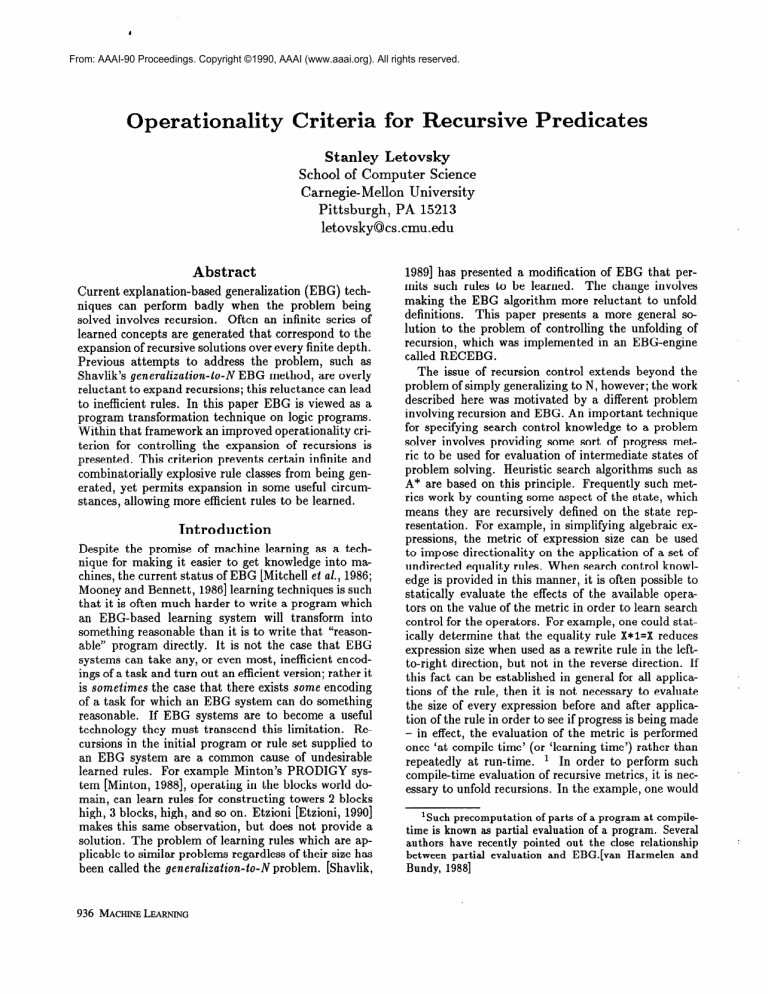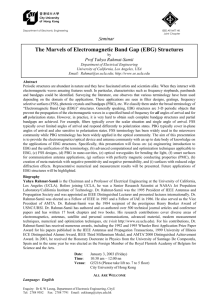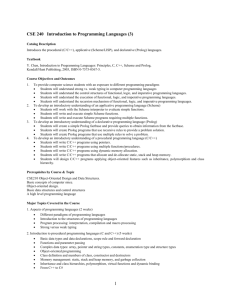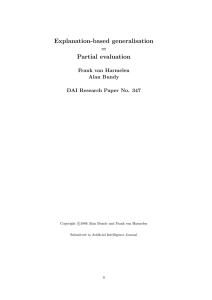
From: AAAI-90 Proceedings. Copyright ©1990, AAAI (www.aaai.org). All rights reserved.
Operationality
Criteria
for Recursive
Predicates
Stanley Letovsky
School of Computer Science
Carnegie-Mellon
University
Pittsburgh,
PA 15213
letovsky@cs.cmu.edu
Abstract
Current explanation-based generalization (EBG) techniques can perform badly when the problem being
solved involves recursion. Often an infinite series of
learned concepts are generated that correspond to the
expansion of recursive solutions over every finite depth.
Previous attempts to address the problem, such as
EBG method, are overly
Shavlik’s generalization-to-N
reluctant to expand recursions; this reluctance can lead
to inefficient rules. In this paper EBG is viewed as a
program transformation technique on logic programs.
Within that framework an improved operationality criterion for controlling the expansion of recursions is
presented. This criterion prevents certain infinite and
combinatorially explosive rule classes from being generated, yet permits expansion in some useful circumstances, allowing more efficient rules to be learned.
Introduction
Despite the promise of machine learning as a technique for making it easier to get knowledge into machines, the current status of EBG [Mitchell et al., 1986;
Mooney and Bennett, 19861 learning techniques is such
that it is often much harder to write a program which
an EBG-based learning system will transform into
something reasonable than it is to write that “reasonable” program directly. It is not the case that EBG
systems can take any, or even most, inefficient encodings of a task and turn out an efficient version; rather it
is sometimes the case that there exists sume encoding
of a task for which an EBG system can do something
reasonable. If EBG systems are to become a useful
technology they must transcend this limitation. Recursions in the initial program or rule set supplied to
an EBG system are a common cause of undesirable
learned rules. For example Minton’s PRODIGY system [Minton, 19881, operating in the blocks world domain, can learn rules for constructing towers 2 blocks
high, 3 blocks, high, and so on. Etzioni [Etzioni, 19901
makes this same observation, but does not provide a
solution. The problem of learning rules which are applicable to similar problems regardless of their size has
been called the generalization-to-N
problem. [Shavlik,
936 MACHINELEARNING
19891 has presented a modification of EBG that permits such rules to be learned. The change involves
making the EBG algorithm more reluctant to unfold
definitions. This paper presents a more general solution to the problem of controlling the unfolding of
recursion, which was implemented in an EBG-engine
called RECEBG.
The issue of recursion control extends beyond the
problem of simply generalizing to N, however; the work
described here was motivated by a different problem
involving recursion and EBG. An important technique
for specifying search control knowledge to a problem
solver involves providing some sort of progress metric to be used for evaluation of intermediate states of
problem solving. Heuristic search algorithms such as
A* are based on this principle. Frequently such metrics work by counting some aspect of the state, which
means they are recursively defined on the state representation. For example, in simplifying algebraic expressions, the metric of expression size can be used
to impose directionality on the application of a set of
undirected equality rules. When search control knowledge is provided in this manner, it is often possible to
statically evaluate the effects of the available operators on the value of the metric in order to learn search
control for the operators. For example, one could statically determine that the equality rule X*1=X reduces
expression size when used as a rewrite rule in the leftto-right direction, but not in the reverse direction. If
this fact can be established in general for all applications of the rule, then it is not necessary to evaluate
the size of every expression before and after application of the rule in order to see if progress is being made
- in effect, the evaluation of the metric is performed
once ‘at compile time’ (or ‘learning time’) rather than
repeatedly at run-time. 1 In order to perform such
compile-time evaluation of recursive metrics, it is necessary to unfold recursions. In the example, one would
‘Such precomputation
of parts of a program at compiletime is known as partial evaluation
of a program.
Several
authors
have recently
pointed out the close relationship
between partial evaluation
and EBG.[van
Harmelen
and
Bundy, 19881
need to count the expression sizes on the left and right
hand sides of the rewrite rule. This in turn requires unfolding the definition of the expression sire metric over
the terms on each side of the equation. Since these
terms contain variables, the unfolding of the metric is
only partial, and the compile time value of the metric is not a number but an algebraic expression. The
effects of the rule on the metric can nontheless be assessed by reasoning about alegebraic inequalities, such
as whether size(X)+2
> size(X),
must be true.
In summary we have the observation that unfolding
of recursions must be limited in order to prevent the
generation of infinite rule sets, yet it must be permitted
in order to allow static evaluation of recursive properties where possible. This paper presents a strategy for
controlling the unfolding of recursions which attempts
to satisfy both of these goals. We will see that there are
limits on solving this problem in general - a strong version of it is equivalent to the halting problem - but that
there are incomplete solutions of demonstrable practical utility. This paper first describes a model of EBG
as transformation of logic programs, then presents the
modifications to the operationality criterion of EBG
that control unfolding. Finally we describe the performance of a series of EBG-like systems on a static
metric evaluation learning problem, including SOAR,
a simple PROLOG-EBG engine, a PROLOG partial
evaluator, and the RECEBG system presented here,
and show that only the last adequately handles the
problem.
EBG as Transformation
of PROLOG
Programs
In this paper we view EBG as a technique for transforming logic programs [Prieditis and Mostow, 1987;
Hirsh, 1987; van Harmelen and Bundy, 19881, specifically pure PROLOG programs. The advantages of this
model of EBG are several. Pure PROLOG programs
have a very simple structure that is convenient to analyze, yet they are expressively as or more powerful
than any other formalism to which EBG techniques
have been applied. A PROLOG program is simply an
AND/OR tree, augmented with recursion and variablebinding mat hinery. This may be contrasted, for example, with the languages used by EBL-systems such
as PRODIGY. PRODIGY specifies programs as sets
of operators with first-order pre- and post-conditions,
plus separate sublanguages for specifying domain theories and search control rules. The language is considerably more complex without being more expressively powerful. PROLOG has the additional advantage of being better known and more widely available,
so that program transformation algorithms expressed
relative to PROLOG can be more readily understood
and tested by others.
The relative simplicity of PROLOG as a programming language carries over to program transformations on the language. EBG has a very simple de-
scription in terms of PROLOG programs [van Harmelen and Bundy, 19881: it corresponds to repeated application of a program transformation I will call expansion, which means the replacement of a subgoal
by one of its definitions. 2 Since PROLOG goals may
have more than one than one definition, more than one
such substitution is possible. Eg. given p(X) :-q(X),
q(X) :-r(X) and q(X) :-s(X), expansion of the definition of q within the definition of p generates two new
definitions of p: p(X) :-r(X)
and p(X) :-s(X).
Exhaustive application of this transformation converts
nonrecursive PROLOG programs to disjunctive normal form. 3 Expansion of recursive programs can
generate infinitely many expansions or simply fail to
terminate.
Note that this model captures only certain aspects of
EBG, chiefly learning from success. In order to capture
other aspects, notably learning from failure, one must
consider transformations that reorder conjuncts and
rules (see eg. [Etzioni, 19901).
The RECEBG
Operationality
Criterion
Within the model of EBG set forth in [Mitchell et al.,
19861 and [Keller, 19861 expansion is controlled by an
operutionulity criterion, which determines which predicates may be replaced by their definitions during the
creation of learned rules. The operationality criterion
controls the level of generality of the learned rules: if it
is reluctant to expand, the rules produced will be more
general; if too eager, the rules will be more specialized.
In order to permit possible nonexpansion of recursive
definitions, the basic EBG algorithm must be modified
to allow for the possibility that more than one learned
rule will be produced from a single example. For example, suppose that a call to a recursively defined predicate called subgoal occurs somewhere in the middle of
a computation of a predicate called goal. If the decision is made not to expand the occurrence of subgoal,
then two rules may be learned: one for goal, containing an unexpanded reference to subgoal, and one for
subgoal, which captures the specialized aspects of the
example with respect to subgoal. [Shavlik, 19891 also
describes this modification.
Once the algorithm has
been modified in this way to permit nonexpansion of
recursions, the interesting question is when to expand.
The following example will be used to elucidate the
operationality criterion:
2Expansion is the PROLOG analog of the X-calculus
operation of P-reduction. The term unfolding is also widely
used for this transformation.
3Such exhaustive expansion in general causes an exponential blow-up in program size, which is certain to increase
the time to fail a goal and very likely to increase the average time to succeed. This highlights the importance of
the operationality criterion for controlling the application
of this potentially dangerous transformation.
LETOVSKY 937
goal(X) :- . . . ,getlist(Y) ,member(X,Y) ,... .
member(A, [A IRest] > .
member(A,[BIRest]) :- member(A,Rest).
Here a nonrecursive predicate, called goal, contains a
reference to the recursively defined predicate member.
The list argument to member is supplied by a second
predicate called getlist
whose definition is not shown.
It is important to distinguish between references to a
recursive predicate that appear outside of the predicate’s definition, such as the call to member inside goal,
and recursive calls occurring within a predicate’s definition, such as the call to member in the second clause
of member. We will refer to the former as external culls,
and the latter as internal culls. The following sections
explain the different components of the operationality
criterion.
Rule#l:
Never
Expand
Internal
Calls
Expansion of internal calls can license an infinite
number of learned rules, corresponding to the infinitely many possible finite recursion depths.
In
the PRODIGY blocks-world example, such expansion
leads to rules for 2-towers, S-towers, etc.
In the
case of member, it leads to additional clauses such
as member(A, [B,A/T]).,
member(A, [B,C,AIT]).,
member(A, [B, C,D, A ITl > . , etc. The assumption that
the cost of matching such rules will remain small as
their number grows without bound is questionable.
Rule#l says to never do this, that such expansions
will not, in general, be a win over simply keeping the
compact recursive definition around. Even if recursion
depth is bounded, if a predicate has several recursive
clauses in its definition, expansion of internal calls can
generate explosively many learned rules: in fact, BD
learned rules, where B is the branching factor - i.e.,
number of disjuncts - and D is the depth of recursion. In the algebraic equation solving domain that
was studied in this research, this effect led to learned
rules that were formed by composing primitive algebraic rewrite rules so that the example equation could
be solved in a single rule; such rules were highly specific
and very numerous.
Rule#l, in conjunction with the algorithmic modifications that allow multiple learned rules from a single
example, is equivalent to Shavlik’s generalization to N
technique.
Rule#2:
Well-Founded
Expansion
of External Calls
Overly eager expansion of external calls can potentially reproduce all of the problems arising from expansion of internal calls, by creating new definitions of the caller instead of the recursive prediFor example we could generate the followcate.
ing rules for goal by expanding the calls that led
to the infinite set of rules for member shown above:
goal(X)
:- . . . , getlist([XiT]),
... ..
etc.
... ..
goal(X)
:- . . . , getlist([A,XIT]),
938 MACHINELEARNING
However, if expansion of getlist
were to result in a
binding of the list variable Y to a list such as [a,b] ,
as in goal(X)
:- . . . , member(X, [a,b]),
. . . . then
expanding the call to member would be a good thing,
because the predicate could be satisfied at compile (or
learning) time. (Two different rules could be generated
by such an expansion, in which X would be bound in
turn to a and to b.)
The problem is to find a way to license those expansions which can perform useful work at compile time,
without opening the door to infinite rule sets in the
caller. The solution used in RECEBG is to allow the
expansion of an external call where that expansion can
be shown to be making progress. The technique is similar to the approach used in [Boyer and Moore, 19791
theorem prover to show that inductive proofs are valid;
the same idea is used in proving termination of programs. The key idea is that in order for the expansion
to be safe, there must exist a well-founded ordering on
the arguments to the recursive predicate which is decreasing over the expansion, and which has a smallest
value. 4 Finding such an ordering in general is equivalent to being able to show whether any program will
terminate; i.e., it is equivalent to the halting problem.
However, in practice a few simple heuristics are capable of generating progress metrics for a broad class of
common problems. For programs that manipulate list
structure, a structural induction metric which counts
the size of the (partially instantiated) list structure is
usually sufficient to provide a well-founded ordering.
Progress metrics for programs which count down to
zero or count up to a fixed value can also be defined.
Together these metrics are sufficient to prove termination for the class of bounded loop programs, i.e., those
programs that can be written using only for-loop-type
iteration constructs.
The structural induction metric in RECEBG counts
the number of leaves in a term’s expression tree, with
variables and atoms counting as one. To determine
whether an external call is well-founded, RECEBG
compares the size of the arguments in the call with
the size of the arguments in the recursive call, i.e., the
recursive call in the body of the predicate after the
head has been unified with the external call. This criterion can easily be improved, since a recursion is well
founded if any argument (or subset of the arguments)
is getting smaller, which may be true even when the
size of all of the arguments together is remaining constant - eg., list reverse.
Another simple extension
would be handling of counter controlled loops, where
< on the natural numbers provides the well-founded
ordering.
Rule#2 says that external calls can be expanded if a
well-founded ordering can be found on any of the arguments. For example, if expansion of getlist
resulted
in Y being bound to [A,B , Xl, the second argument to
the member call would be [A,B ,X1 before expansion,
and [B ,X] in the new call resulting from the expansion (assuming that A was not equal to X in the example). Since [B ,X] has fewer list elements than [A ,B ,Xl
the expansion is making progress, and therefore can be
carried out safely.
Note that an external call containing only variables,
such as member(X, Y) , would never be expanded under
this rule, while an call containing partially instantiated variables, such as member(X, [Y, Z] ) , will be expanded. In the former case, however, expansion of
other predicates that share the variable Y could specialize it so that the call to member would become expandable. Therefore whenever a variable is specialized by
expansion during the EBG process, any unexpanded
recursive calls must be rechecked to see if they have
become expandable. Note also that such variable specializations are determined by the code only, they are
not supplied by the example. The example enters in
only in the selection of control flow paths through the
code. The result is that calls are expanded only to the
extent warranted by the variable specializations in the
learned rule, rather than the bindings in the example.
Rule#3:
Forced
Termination
Expansion
The trickiest aspect of the expansion control concerns
the conditions under which, when the example chose
the terminal case in an external call, the learned rule
should incorporate that choice rather than simply retaining the call to the recursive predicate. Eg., suppose
that during an call of member(X,Y) , the corresponding goal in the example was member(1, [l ,21> , which
succeeds immediately. Should the call be expanded,
eliminating the call to member and binding Y to [Xl
in the learned rule? Unwanted expansions yield overly
specific learned rules that incorporate too much detail
from the example, while missed opportunities to expand can lead to inefficient rules that fail to exploit the
information provided by the example. The inefficiency
can extend well beyond the predicate in question, since
the failure to expand one predicate can cause variables
to go unspecialized, leading to a failure to expand other
predicates via Rule #2.
Examination of numerous examples suggests that
sometimes expanding the terminal case is the right
thing to do, while other times retaining the call leads to
better rules. The feature that distinguishes those cases
where expansion is desirable is that in those cases, the
terminal branch is the only logically possible choice, at
the level of the learned rule rather than the example.
In other words, the recursive branch(es) can be statically shown to be contradictory, so that the recursive
branch can never be taken. Rule#3 says that if this can
be proved, then the recursive call should be replaced
by its terminal case definition.
Proving the applicability of Rule#3 requires statically showing that the recursive definitions are inapplicable. The example cannot be appealed to to assist
in this proof, because the proof must hold across all
examples. It is not possible to provide a complete capability for detecting forced termination, short of providing a complete theorem prover. However, numerous
simple cases can be recognized, which provide considerable leverage in practice. The easiest refutations are
obtained when the call fails to unify with the heads of
the recursive clauses, as occurs in the most common
PROLOG recursion cliche, where p( Cl > cannot match
p( [H 1T] ) . If no recursive clause can unify, termination is forced. In addition, RECEBG contains a small
set of simplification rules which can sometimes simplify conjuncts in the recursive clause to false after the
head has been unified with external call, thus showing
the inapplicability of the clause. These rules provide a
poor-man’s theorem prover; adding strong typing and
static type-checking machinery would be a useful extension of this idea. Incompleteness in the reasoner’s
ability to refute the recursive branches causes Rule#S
to fail to apply in places where it ought to, resulting in
inefficient, overly general learned rules. If one must err,
it is better to err on the side of overly general rules,
because there are usually fewer of them than overly
specific rules, and the effect on performance is likely
to be less bad.
Evaluating
RECEBG
This section describes the outcome of attempts to solve
a learning problem involving complex recursion unfoldings on four different EBG-like systems: the SOAR
learning architecture, a simple EBG-engine for pure
PROLOG, a partial evaluator for pure PROLOG, and
finally the RECEBG system that incorporates the operationality criterion described above. We first describe the target problem.
The
Isolation
Example
PRESS [Bundy, 19831 is a program for solving algebraic equations. It is notable in that it provides a
coherent theory of search control for the application of
algebraic rewrite rules. In PRESS, the rewrite rules
of algebra are grouped into sets called strategies, each
of which helps achieve a different subgoal of the task
of solving an equation. Here we will consider only one
such strategy, called Isolation, which applies to equations that contain a single occurence of the unknown
on the left hand side, and no occurrences on the right
hand side. Isolation strips away away function applications from the left hand side until the unknown is
isolated. At that point the equation is solved. Isolation rules work by applying the inverse of the function
being eliminated to both sides of the equation. Eg.
A+B=C
A*B=C
sin(A) = B
=+
a
j
A=C-B
A=C/B
A = arcsin
LETOVSKY 939
PRESS’s search-control theory can be viewed as a sequence of loops, each of which applies operators until
some metric of badness is reduced to zero. In the case
of the isolation strategy, the metric is depth of nesting
of the unknown
on the left-hand
side.
The problem of learning search control for an operator given a progress metric can be formulated as
follows: form new “search-controlled” operators from
the original uncontrolled operator by adding to its preconditions the weakest additional constraints that will
guarantee that the operator application reduces the
metric. For example, if the operator is the rewrite rule
A+B=C 3 A=C-B and the metric is depth of nesting of
the unknown on the LHS, the additional precondition
would be that the unknown is a subterm of A. To do
this, the learner must statically evaluate the operators’
effects on the metric’s value. Below we describe attempts to implement this behavior in 4 different EBGengines.
PRESS-SOAR
PRESS-SOAR is an attempt to learn PRESS-style
search control within SOAR. SOAR [Laird et al., 1987;
Rosenbloom and Laird, 19861 is a problem-solver that
incorporates an EBG-style learning component. The
intent was to provide the system with algebraic operators - rewrite rules - together with a metric for assessing progress, and have it learn the conditions under
which the operators make progress in reducing the metric. The metric used was the depth-of-nesting metric
appropriate for isolation. In PRESS-SOAR problem
solving begins in a problem space containing only rules
with the desired search control knowledge; this space
is initially empty. When no operator is applicable, an
impasse occurs, invoking a promiscuous-proposal
problem space. In this space any rewrite rule matching the
expression can apply, but a check must be performed
to verify that the rule application does in fact reduce
depth of nesting before the rule will be selected. The
goal was to have SOAR’s chunking machinery chunk
over these impasses to yield rewrite rules which are
only considered in circumstances where they reduce
depth of nesting.
The early versions of PRESS-SOAR which functioned correctly apart from chunking did not generate
the desired chunks. Instead they generated radically
overspecific chunks, which incorporated many of the
features of the particular problem instances that SOAR
had been exposed to, including such features as the
entire left hand side term structure, or the particular
nesting depth before and after rewriting. Developing a
version of PRESS-SOAR which produced the desired
chunks required careful attention to what information
was computed before versus during the impasse. In
general, to get desired chunks in SOAR, one must
ensure that all the “compile time” computations occur within an impasse. In effect the impasse/multiple
940 MACHINE LEARNING
problem space mechanisms in SOAR function to allow
the programmer to determine which parts of computation should occur “at compile time”, thereby allowing the programmer to define an operationality criterion tailored to the problem at hand. The question of
how to automatically determine operationality is thus
closely related to the question of how to automatically
organize knowledge into separate problem spaces.
PROEBG:
A PROLOG
EBG-Engine
PROEBG is a simple EBG-engine for pure PROLOG,
closely modelled on the ebg program presented in [van
Harmelen and Bundy, 1988]. It builds a new disjunct
for a goal by finding the set of primitives evaluated in
the course of solving an example. The results contain
no calls to defined functions, and tend to contain many
trivial wasteful steps - eg., goals that are obviously
true by inspection, regardless of how the variables are
bound - that are simplified in a postprocessing step.
% Apply rewrite rules that reduce the vneasure, until done.
isolate(X,X=Exp,X=Exp).
isolate(X,LHS=RHS,Solution) :not(LHS=X),
rule(LHS=RBS,NeuLHS=NewRHS),
don(X,LHS,Don),
don(X,NewLHS,NewDon),
NewDon < Don,
isolate(X,NewLHS=NewRHS,Solution).
don(Var,Var,O).
don(Var,Trm,Don) :Trm 8.. cop I Argsl ,
member(Sub,Args).
don(Var,Sub,D),
Don is D+l.
rule(A+B=C,A=C-B).
rule(A*B=C,A=C/B).
rule(A+B=C,B=C-A).
...
PROEBG was applied to the PROLOG version
of isolate
shown above.
From the standpoint of
the isolation search-control learning task, PROEBG
was a disappointment.
Its problems were very similar to those of PRESS-SOAR: unwanted incorporation of specific details of the examples resulting in
undergeneral chunks. A rule learned by PROEBG
is essentially a composition of all the rewrite rules
used in solving the example.
For example, given
the goal isolate(x,3*~+2=y,Result), itwould learn
isolate(X,A*X+B=C,X=(C-B)/A).
PROPE:
A PROLOG
Partial
Evaluator
PROPE is a partial evaluator for pure PROLOG programs written by the author. To the simple peval
code of described in [van Harmelen and Bundy, 19881,
PROPE adds the full RECEBG operationality criterion, plus some algebraic simplification capabilities.
Note however that a partial evaluator, unlike an EBG
engine, performs its analysis statically, without benefit
of an example.
The problem with PROPE was that, although it
was able to generate the desired rules, it generated
too many learned rules, many of which corresponded
to computations that could never occur. For example, when expanding the rule A+B=C + A=C-B inside
isolate,
it was able to perform well-founded expansions of the don predicate over the equations A+B=C
and A=C-B. The predicate member is expanded two different ways within the first call to don - one assumes
that X is a subterm of A, the other, B. The second call
to don assumes X is a subterm of A. Hence, one pair of
assumptions will be impossible:
isolate(X,A+B=C,New)
don(X,B,I),
don(X,A, J>,
I < J,...
.
:-
example detail and provide very little coverage. An
operationality criterion which is overly conservative
about expanding recursions will avoid these infinities
but be condemned to repeatedly computing at runtime
results
which
could
be computed
at learning
time.
A partial evaluator which statically expands recursions
as much as possible can generate large numbers of spurious learned rules due to lack of domain knowledge
and/or theorem proving power. An EBG engine that
opportunistically expands recursions at learning time
was exhibited which avoids all of these pitfalls.
Acknowledgements
... ,
The author thanks Scott Dietzen, Oren Etzioni and
Allen Newell for helpful comments on this manuscript.
The problem is that PROEBG lacks some knowledge
about these equations, namely, that there is only one
occurence of X and that if it is a subterm of a rule
variable before rewriting, it will be a subterm of that
same variable after rewriting. Both domain knowledge
and some reasoning ability are required to prove that
the execution paths corresponding to these “impossible” rules contained contradictory assumptions. Here
we see the EBG advantage over partial evaluation: by
focussing attention on paths that are known to be realizable, EBG gets the equivalent of theorem-proving
power and domain-knowledge from the world cheaply.
RECEBG
RECEBG incorporates the inproved operationality criterion within an example-guided framework. In addition to the modified operationality criterion described
above, RECEBG incorporates a Fortuitous Unification
Rude, which allows it to collapse 2 calls to the same
predicate when those calls return identical results in
an example. This rule allows the two calls to don in
isolate to be reduced to a single call, after expansion
has rendered their arguments identical. RECEBG also
requires some post-EBG simplification of algebraic inequalities in learned rules.
RECEBG is able to produce the desired rules by expanding recursions at compile time as much as possible, while restricting its attention to logically possible
control-flow paths because of the example guidance.
For example, the rule learned to govern the isolation
of sum-terms is:
isolate(X,A+B=C,New)
:don(X,A,I),
isolate(X,A=C-B,New).
Note that the output I of don is no longer used; the
call to don now functions only to ensure that A contains
X. Similar rules are learned for the other operators.
Conclusions
Recursive predicates are not well-handled by current
EBG systems. A simple-minded, overly eager operationality criterion can produce an infinite number of
overly specific learned rules that incorporate too much
References
Boyer,
Robert S. and Moore, J. Strother
tational Logic. Academic Press.
Bundy,
Alan
1983.
maticaZ Reasoning.
Etzioni,
Oren
1990.
The Computer
Academic
Why
1979.
A Compu-
Modelling
of Mathe-
Press.
prodigy/ebl
ceedings of the Eighth National
Intelligence.
works.
Conference
In Proon Artijkial
Hirsh, Haym 1987. Explanation-based
generalization
in a
logic-programming
environment.
In Proceedings of AAAI87. American
Association
for Artificial Intelligence.
Keller,
Richard
1986.
Defining
operationality
for
explanation-based
learning.
In Proceedings of AAAI-87.
American
Association
for Artificial Intelligence.
Laird, J.; Newell, A.; and Rosenbloom,
An architecture
for general intelligence.
P. 1987.
SOAR:
Artificial
Intelli-
gence 33( l):l-64.
Minton,
Steve
Knowledge:
sertation,
1988. Learning Eflective Search-Control
An Explanation-Based
Approach. Ph.D. Dis-
Carnegie-Mellon
University.
Mitchell,
T.;
R.Keller,
; and
Explanation-based
generalization:
chine Learning l(1).
S.Kedar-Cabelli,
1986.
A unifying view. Ma-
Mooney, Raymond and Bennett,
Scott 1986. A domain independent
explanation-based
generalizer.
In Proceedings
of AAAI-86.
American
Association
for Artificial Intelligence.
Prieditis, Armand and Mostow,
wards a prolog interpreter
that
AAAI-87. American Association
Jack 1987. Prolearn:
Tolearns. In Proceedings of
for Artificial Intelligence.
Rosenbloom,
Paul and Laird,
John 1986.
Mapping
Explanation-Based
Generalization
onto SOAR.
In Proceedings of AAAI-86. American Association for Artificial
Intelligence.
Shavlik, Jude 1989. Acquiring recursive and iterative concepts with explanation-based
learning.
Technical Report
#876,
University of Wisconsin,
Madison.
van Harmelen, Frank
Based Generalisation
36:401-412.
and Bundy,
= Partial
Alan 1988.
Evaluation.
Explanation-
AI Journal
LETOVSKY 941








